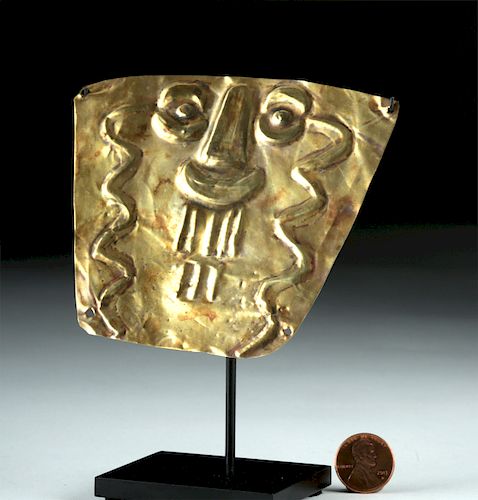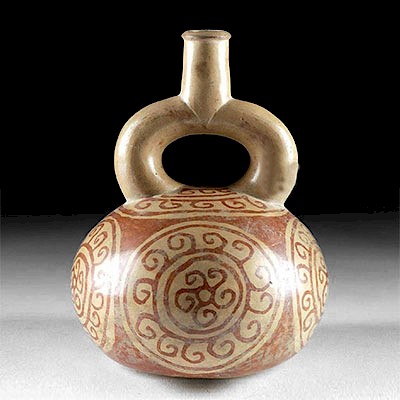Paracas 12K Gold Mask of Trophy Head
Lot 64d
About Seller
Artemis Fine Arts
686 S Taylor Ave, Ste 106
Louisville, CO 80027
United States
Selling antiquities, ancient and ethnographic art online since 1993, Artemis Gallery specializes in Classical Antiquities (Egyptian, Greek, Roman, Near Eastern), Asian, Pre-Columbian, African / Tribal / Oceanographic art. Our extensive inventory includes pottery, stone, metal, wood, glass and textil...Read more
Estimate:
$6,000 - $8,000
Absentee vs Live bid
Two ways to bid:
- Leave a max absentee bid and the platform will bid on your behalf up to your maximum bid during the live auction.
- Bid live during the auction and your bids will be submitted real-time to the auctioneer.
Bid Increments
| Price | Bid Increment |
|---|---|
| $0 | $25 |
| $300 | $50 |
| $1,000 | $100 |
| $2,000 | $250 |
| $5,000 | $500 |
| $10,000 | $1,000 |
| $20,000 | $2,500 |
| $50,000 | $5,000 |
| $100,000 | $10,000 |
| $200,000 | $20,000 |
About Auction
By Artemis Fine Arts
Jan 24, 2019
Set Reminder
2019-01-24 10:00:00
2019-01-24 10:00:00
America/New_York
Bidsquare
Bidsquare : Pre-Columbian / Ethnographic Art
https://www.bidsquare.com/auctions/artemis-gallery/pre-columbian-ethnographic-art-3814
Featuring ancient and ethnographic art from around the world, including Pre-Columbian, Native American, African / Tribal, Ethnographic, Spanish Colonial, Fossils, Fine Art, much more. Artemis Fine Arts info@artemisgallery.com
Featuring ancient and ethnographic art from around the world, including Pre-Columbian, Native American, African / Tribal, Ethnographic, Spanish Colonial, Fossils, Fine Art, much more. Artemis Fine Arts info@artemisgallery.com
- Lot Description
Pre-Columbian, South Coast Peru, Paracas, ca. 500 BCE. Among the earliest gold masks from the ancients of Peru, depicting a trophy head and skillfully hammered in repousse from gold sheet (51% gold, ~12K). Notice the vertical pins closing the mouth and the sinuous, tears streaming from the corners of his eyes. A very fine example with perforations at corners for attachment. Mummified trophy heads date to the pre-ceramic period in ancient Peru. Perhaps the most extensive practice of headhunting occurred along the south coast of Peru in the Nazca and Inca valleys where the early Paracas and succeeding Nazca cultures resided. Head-taking was a significant component of their warfare and religious mythology. A warrior could increase his might and status by capturing prisoners for head-taking. Size: 4.25" W x 3.875" H (10.8 cm x 9.8 cm); 5" H (12.7 cm) on included custom stand.
According to scholar Paul A. Clifford, the fact that the lips of trophy heads are pinned shut " . . . implies that head-taking might mean the acquisition of a slain enemy's power or the prevention of his soul or spirit from harming the killer. Pinning lips shut on the trophy head could inhibit the loss of the soul or power embodied within the head." (cf. Art of the Andes: Pre-Columbian Sculptured and Painted Ceramics from the Arthur M. Sackler Collections, The Arthur M. Sackler Foundation: Washington D.C., 1983, p. 251.)
Provenance: private Hawaii, USA collection; ex-private Arundel collection, "Old Curiosity Cabinet", Melrose Avenue, Los Angeles, California, USA
All items legal to buy/sell under U.S. Statute covering cultural patrimony Code 2600, CHAPTER 14, and are guaranteed to be as described or your money back.
A Certificate of Authenticity will accompany all winning bids.
We ship worldwide and handle all shipping in-house for your convenience.
#139282Perforations at corners for attachment. Slight denting commensurate with age, but overall excellent with a nice glowing, warm patina.Condition
- Shipping Info
-
All shipping is handled in-house for your convenience. Your invoice from Artemis Gallery will include shipping calculation instructions. If in doubt, please inquire BEFORE bidding for estimated shipping costs for individual items.
-
- Buyer's Premium



 EUR
EUR CAD
CAD AUD
AUD GBP
GBP MXN
MXN HKD
HKD CNY
CNY MYR
MYR SEK
SEK SGD
SGD CHF
CHF THB
THB














